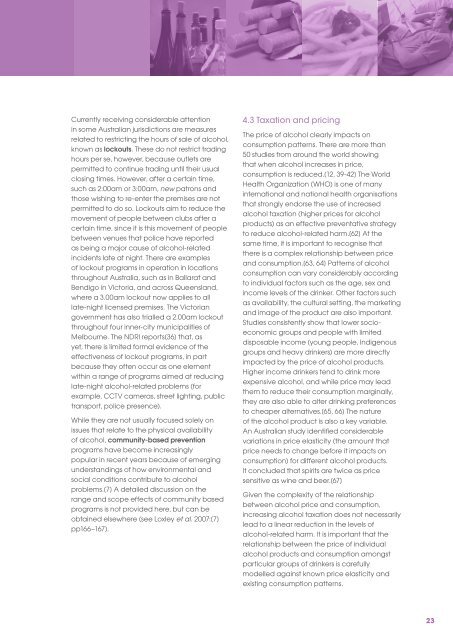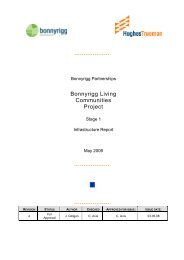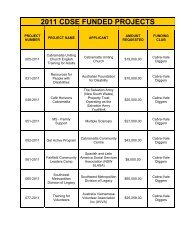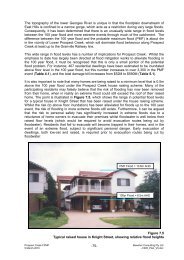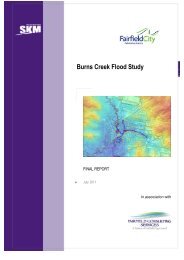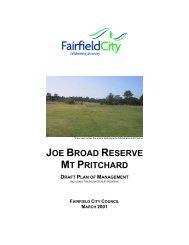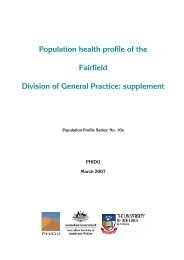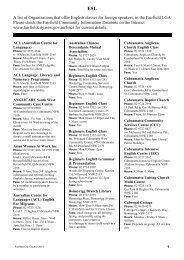The dist<strong>in</strong>ction is important because while allstate and territory laws <strong>in</strong> <strong>Australia</strong>n prohibita m<strong>in</strong>or from purchas<strong>in</strong>g alcohol, they do notnecessarily prohibit consumption <strong>in</strong> certa<strong>in</strong>circumstances. Babor et al. emphasise thatconsistent enforcement <strong>of</strong> laws regard<strong>in</strong>gpurchase age is critical if reduced alcoholconsumption and <strong>related</strong> harm among youngpeople is to be achieved.[13] Although them<strong>in</strong>imum legal purchase age for alcohol <strong>in</strong> all<strong>Australia</strong>n jurisdictions is 18 years, the averageage at which <strong>Australia</strong>ns have their first fullserve <strong>of</strong> alcohol is 17 years, and as detailedearlier <strong>in</strong> this paper, there is a high prevalence<strong>of</strong> underage dr<strong>in</strong>k<strong>in</strong>g that has not changedsignificantly <strong>in</strong> the past 20 years. In the US,where the m<strong>in</strong>imum legal purchase age forsome time ranged between 18 and 21 years,several studies have found that <strong>in</strong>creas<strong>in</strong>g theage limit is an effective means <strong>of</strong> reduc<strong>in</strong>groad crash death and <strong>in</strong>jury among teenagersand young adults. The NDRI reports[36] thatsome studies have also found that the higherlegal m<strong>in</strong>imum dr<strong>in</strong>k<strong>in</strong>g age is associated withreductions <strong>in</strong> alcohol consumption amongyoung people. There is, therefore, someevidence that rais<strong>in</strong>g the purchase age to21 can reduce teenage dr<strong>in</strong>k<strong>in</strong>g, as well asharms. Kypri’s account[59] <strong>of</strong> recent attemptsto <strong>in</strong>crease the m<strong>in</strong>imum purchase age <strong>in</strong>New Zealand to 20 demonstrated that populardebate conv<strong>in</strong>ced a majority <strong>of</strong> the public thatrais<strong>in</strong>g the age would be an appropriate wayto reduce young people’s harm from dr<strong>in</strong>k<strong>in</strong>g.Toumbourou et al. here <strong>in</strong> <strong>Australia</strong> haverecommended that a first step <strong>in</strong> this directionwould be better monitor<strong>in</strong>g <strong>of</strong> alcohol-<strong>related</strong>developmental harms us<strong>in</strong>g longitud<strong>in</strong>al andother developmental research.[41]It must be acknowledged that consumption<strong>of</strong> alcohol by children and adolescents <strong>in</strong> thehome and <strong>in</strong> certa<strong>in</strong> social sett<strong>in</strong>gs is <strong>of</strong>tensanctioned by parents, <strong>of</strong>ten <strong>in</strong> the belief thatit is relatively harmless or might be helpful <strong>in</strong>educat<strong>in</strong>g young people about alcohol.[60]The majority <strong>of</strong> young <strong>Australia</strong>ns who reportdr<strong>in</strong>k<strong>in</strong>g at home also report parents as be<strong>in</strong>gthe primary suppliers <strong>of</strong> their alcohol.[61]In New South Wales, it is now an <strong>of</strong>fence tosupply alcohol to m<strong>in</strong>ors <strong>in</strong> a private homewithout the direct approval <strong>of</strong> a parent orguardian. This has <strong>of</strong>ten been referred to as theNSW secondary supply law. While the impact<strong>of</strong> this law on youth dr<strong>in</strong>k<strong>in</strong>g is not yet known,legislation <strong>of</strong> this k<strong>in</strong>d has been welcomedby advocates aga<strong>in</strong>st alcohol-<strong>related</strong> harmand there is currently considerable lobby<strong>in</strong>g<strong>of</strong> government to support the <strong>in</strong>troduction <strong>of</strong>similar laws <strong>in</strong> other <strong>Australia</strong>n jurisdictions.[60]Another example <strong>of</strong> restrictions on the physicalavailability <strong>of</strong> alcohol, which is known to beeffective <strong>in</strong> reduc<strong>in</strong>g alcohol-<strong>related</strong> harm<strong>in</strong> some <strong>Australia</strong>n Indigenous communities,is referred to as dry community declarations.[36] Some remote Indigenous communities <strong>in</strong>Western <strong>Australia</strong>, the Northern Territory andSouth <strong>Australia</strong> have declared themselves ‘dry’,us<strong>in</strong>g provisions <strong>of</strong> state/territory legislation.The key element <strong>of</strong> such dry area declarationsis a comb<strong>in</strong>ation <strong>of</strong> Indigenous communitycontrol and statutory authority, along withpolice enforcement for ensur<strong>in</strong>g that drycommunity declarations reach their potential.Evidence suggests that although there areshortcom<strong>in</strong>gs (for example, sly grogg<strong>in</strong>g) andassociated costs to this approach, overallthere are reductions <strong>in</strong> consumption andalcohol-<strong>related</strong> harm. It should be notedthat dry community declarations are dist<strong>in</strong>ctfrom local dry area alcohol bans, as the latterrelate to restrictions on dr<strong>in</strong>k<strong>in</strong>g <strong>in</strong> designatedpublic places and are usually imposedwhere there are high rates <strong>of</strong> alcohol-<strong>related</strong>public disorder.[36] While local dry area banshave been found to decrease public orderproblems <strong>in</strong> designated areas, overall it is notyet fully known if they reduce public order<strong>of</strong>fences, alcohol-<strong>related</strong> hospitalisations orpolice detentions <strong>of</strong> <strong>in</strong>toxicated persons. Oftendry area restrictions simply displace dr<strong>in</strong>kersto other areas where there are no, or fewer,restrictions, and dry area declarations are <strong>of</strong>tenseen as <strong>in</strong>herently discrim<strong>in</strong>atory because <strong>of</strong>the negative impacts on Indigenous peoplealready at risk <strong>of</strong> alcohol problems.[36]22
Currently receiv<strong>in</strong>g considerable attention<strong>in</strong> some <strong>Australia</strong>n jurisdictions are measures<strong>related</strong> to restrict<strong>in</strong>g the hours <strong>of</strong> sale <strong>of</strong> alcohol,known as lockouts. These do not restrict trad<strong>in</strong>ghours per se, however, because outlets arepermitted to cont<strong>in</strong>ue trad<strong>in</strong>g until their usualclos<strong>in</strong>g times. However, after a certa<strong>in</strong> time,such as 2:00am or 3:00am, new patrons andthose wish<strong>in</strong>g to re-enter the premises are notpermitted to do so. Lockouts aim to reduce themovement <strong>of</strong> people between clubs after acerta<strong>in</strong> time, s<strong>in</strong>ce it is this movement <strong>of</strong> peoplebetween venues that police have reportedas be<strong>in</strong>g a major cause <strong>of</strong> alcohol-<strong>related</strong><strong>in</strong>cidents late at night. There are examples<strong>of</strong> lockout programs <strong>in</strong> operation <strong>in</strong> locationsthroughout <strong>Australia</strong>, such as <strong>in</strong> Ballarat andBendigo <strong>in</strong> Victoria, and across Queensland,where a 3.00am lockout now applies to alllate-night licensed premises. The Victoriangovernment has also trialled a 2.00am lockoutthroughout four <strong>in</strong>ner-city municipalities <strong>of</strong>Melbourne. The NDRI reports[36] that, asyet, there is limited formal evidence <strong>of</strong> theeffectiveness <strong>of</strong> lockout programs, <strong>in</strong> partbecause they <strong>of</strong>ten occur as one elementwith<strong>in</strong> a range <strong>of</strong> programs aimed at reduc<strong>in</strong>glate-night alcohol-<strong>related</strong> problems (forexample, CCTV cameras, street light<strong>in</strong>g, publictransport, police presence).While they are not usually focused solely onissues that relate to the physical availability<strong>of</strong> alcohol, community-based preventionprograms have become <strong>in</strong>creas<strong>in</strong>glypopular <strong>in</strong> recent years because <strong>of</strong> emerg<strong>in</strong>gunderstand<strong>in</strong>gs <strong>of</strong> how environmental andsocial conditions contribute to alcoholproblems.[7] A detailed discussion on therange and scope effects <strong>of</strong> community basedprograms is not provided here, but can beobta<strong>in</strong>ed elsewhere (see Loxley et al. 2007:[7]pp166–167).4.3 Taxation and pric<strong>in</strong>gThe price <strong>of</strong> alcohol clearly impacts onconsumption patterns. There are more than50 studies from around the world show<strong>in</strong>gthat when alcohol <strong>in</strong>creases <strong>in</strong> price,consumption is reduced.[12, 39-42] The World<strong>Health</strong> Organization (WHO) is one <strong>of</strong> many<strong>in</strong>ternational and national health organisationsthat strongly endorse the use <strong>of</strong> <strong>in</strong>creasedalcohol taxation (higher prices for alcoholproducts) as an effective preventative strategyto reduce alcohol-<strong>related</strong> harm.[62] At thesame time, it is important to recognise thatthere is a complex relationship between priceand consumption.[63, 64] Patterns <strong>of</strong> alcoholconsumption can vary considerably accord<strong>in</strong>gto <strong>in</strong>dividual factors such as the age, sex and<strong>in</strong>come levels <strong>of</strong> the dr<strong>in</strong>ker. Other factors suchas availability, the cultural sett<strong>in</strong>g, the market<strong>in</strong>gand image <strong>of</strong> the product are also important.Studies consistently show that lower socioeconomicgroups and people with limiteddisposable <strong>in</strong>come (young people, Indigenousgroups and heavy dr<strong>in</strong>kers) are more directlyimpacted by the price <strong>of</strong> alcohol products.Higher <strong>in</strong>come dr<strong>in</strong>kers tend to dr<strong>in</strong>k moreexpensive alcohol, and while price may leadthem to reduce their consumption marg<strong>in</strong>ally,they are also able to alter dr<strong>in</strong>k<strong>in</strong>g preferencesto cheaper alternatives.[65, 66] The nature<strong>of</strong> the alcohol product is also a key variable.An <strong>Australia</strong>n study identified considerablevariations <strong>in</strong> price elasticity (the amount thatprice needs to change before it impacts onconsumption) for different alcohol products.It concluded that spirits are twice as pricesensitive as w<strong>in</strong>e and beer.[67]Given the complexity <strong>of</strong> the relationshipbetween alcohol price and consumption,<strong>in</strong>creas<strong>in</strong>g alcohol taxation does not necessarilylead to a l<strong>in</strong>ear reduction <strong>in</strong> the levels <strong>of</strong>alcohol-<strong>related</strong> harm. It is important that therelationship between the price <strong>of</strong> <strong>in</strong>dividualalcohol products and consumption amongstparticular groups <strong>of</strong> dr<strong>in</strong>kers is carefullymodelled aga<strong>in</strong>st known price elasticity andexist<strong>in</strong>g consumption patterns.23


